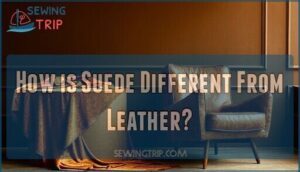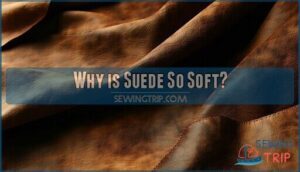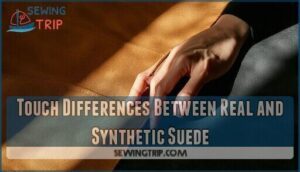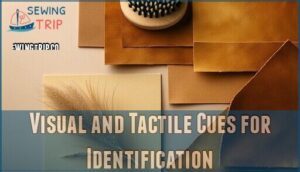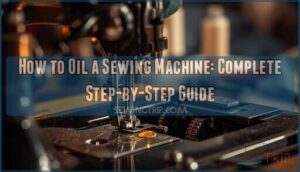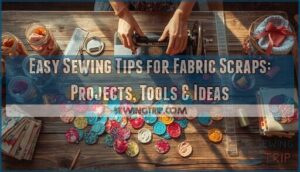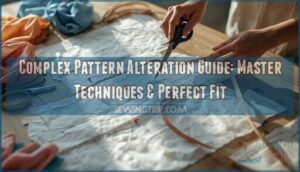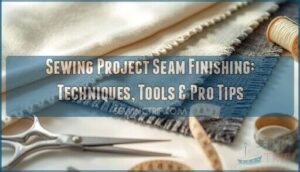This site is supported by our readers. We may earn a commission, at no cost to you, if you purchase through links.

Its napped texture creates a friction that makes it feel both soft and substantial at the same time. The plushness shifts depending on how you brush it: smooth with the grain, slightly rough against it.
This texture, combined with suede’s natural flexibility and breathability, is why designers use it for everything from jackets that move with you to shoes that mold to your feet. Understanding suede’s unique feel helps you spot quality pieces, care for them properly, and appreciate why it stands out in fashion and interiors.
Table Of Contents
- Key Takeaways
- What Does Suede Feel Like?
- How is Suede Different From Leather?
- Why is Suede So Soft?
- Real Vs. Faux Suede Texture
- Suede Vs. Nubuck Vs. Microsuede
- Is Suede Comfortable to Wear?
- Does Suede Scratch or Mark Easily?
- How Does Suede Perform Over Time?
- How to Care for Suede’s Texture
- Popular Uses of Suede in Fashion
- Frequently Asked Questions (FAQs)
- Conclusion
Key Takeaways
- Suede’s signature velvety softness comes from its napped surface structure—thousands of tiny fibers standing upright on the inner layer of animal hide—which creates a distinctive tactile warmth and gentle friction (coefficient 0.4–0.7) that sets it apart from smooth leather’s cool, polished feel.
- Real suede develops natural character over time through wear and requires dedicated care with specialized brushes and waterproofing sprays, while synthetic alternatives like microsuede offer uniform texture and easier maintenance but lack the breathability, warmth, and aging patina of genuine material.
- The material’s flexibility and breathability make it ideal for garments and accessories that move with your body, though its delicate napped texture shows scratches and water damage more readily than smooth leather—requiring protective treatments and gentle handling to preserve its luxurious feel.
- Quality suede can last years with proper storage in breathable containers, regular brushing to lift the nap, and seasonal waterproofing applications, though environmental factors like humidity over 60% and direct sunlight exposure significantly accelerate texture degradation and color fading.
What Does Suede Feel Like?
When you run your fingers across suede, you’ll notice something unmistakable—a velvety softness that sets it apart from smooth leather or stiff fabrics. The texture is warm, plush, and slightly fuzzy, almost like brushing your hand against fine velvet or soft peach skin.
To understand why suede feels this distinctive, we need to explore its tactile qualities, the science of its softness, and how it compares to familiar materials.
Tactile Qualities of Suede
When you run your hand across suede, you’ll notice something different right away—a velvety resistance that feels almost alive, softer than most leathers yet somehow more textured than velvet. That tactile sensation comes from suede’s distinctive napped surface, where tiny fibers stand upright and form a plush, directional feel. This is what makes suede texture unique:
- Friction coefficient ranges between 0.4 and 0.7, giving you gentle grip without stickiness
- Surface roughness generates warmth under your fingertips, unlike smooth leather’s cool touch
- Directional pile means brushing one way feels silkier than the other
That plush texture is exactly why suede stands apart from other leathers—and why running a brush over it regularly matters so much.
Keeping those fibers standing upright preserves that signature softness under your fingertips.
Softness and Texture Explained
Suede’s signature softness isn’t just about how it feels—it’s built into the material’s structure, where fiber density, surface texture, and finishing techniques combine to produce that unmistakable plush feel. Analyzing texture reveals how material science transforms raw hide into the velvet finish you instantly recognize.
| Element | How It Creates Softness |
|---|---|
| Suede Fibers | Loosened through sanding to stand upright, creating plush resistance |
| Napped Surface | Micro-level roughness (0.4–0.7 friction coefficient) produces warmth |
| Inner Hide Layer | Naturally softer, more pliable than outer leather layers |
| Finishing Process | Controlled buffing aligns fibers for consistent texture |
| Softness Metrics | Surface roughness correlates at 0.902 with tactile comfort perception |
It’s this combination of factors that gives suede its distinctive look and feel—a softness you simply won’t encounter in regular leather.
Plushness Compared to Other Fabrics
You might already know suede by its plush feel, but placing it alongside velvet, wool, or microfiber reveals exactly where it stands—and why textile specialists measure its warmth, grip, and tactile depth differently than smoother alternatives.
Softness alone doesn’t explain what you’re experiencing with suede—it’s the engineered structure of those plush fibers that creates its distinctive feel.
- Velvet offers silky softness but lacks suede’s friction coefficient (0.4–0.7), making it slip rather than grip.
- Wool provides insulation yet can’t match suede’s micro/nano fiber structure for plush resistance.
- Microfiber mimics texture but delivers synthetic flatness instead of suede’s natural, coarser warmth.
- Leather emphasizes long-lasting wear and appearance over the napped softness metrics that define suede’s material comparison advantage.
How is Suede Different From Leather?
While both come from animal hide, suede and leather feel completely different in your hands. The key differences lie in how they’re made, what they look like, and how they hold up over time.
We’ll break down texture, appearance, and durability to show you what makes each material unique.
Suede Vs. Leather Texture
Run your fingers over leather and suede side by side, and the difference is instantly clear. One feels smooth and cool, while the other greets your hand with a warm, soft grip that draws you in.
Leather has a polished, almost waxy surface that resists your touch, while suede’s fuzzy finish invites you closer with its plush, textured feel.
This contrast highlights key differences in how these materials hold up and respond to touch—leather shows clear grain patterns and a tight structure, while suede offers a unique softness that sets it apart from anything else in the leather vs. suede comparison.
Surface Appearance and Finish
Look closely at the two materials under good light, and the visual contrast becomes just as striking as the difference in touch.
Suede displays a velvet texture with uniform fuzziness, while leather reveals clear leather grain patterns and a glossy sheen. This surface roughness defines their material aesthetics:
- Suede finishing creates a matte, non-reflective look that absorbs light
- Leather care and maintenance preserves the polished, mirror-like surface
- A suede brush lifts the nap, restoring its characteristic softness
- The suede vs leather comparison shows leather’s tight, smooth finish versus suede’s raised, textured appearance
That’s why suede leather looks softer and less formal than its polished counterpart.
Durability and Flexibility
Though both come from animal hides, their practical qualities tell a different story. Suede trades some longevity for excellent stretch and flexibility, while leather types and characteristics focus on toughness.
Check out how they compare:
| Property | Suede | Leather |
|---|---|---|
| Wear resistance | Shows wear after 20,000 cycles | Withstands 30,000+ cycles |
| Suede longevity | 3–4 years with heavy use | Decades with good care |
| Flexibility | Greater bend and movement | Stiffer, more structured |
| Material fatigue | Faster surface wear | Resists cracking longer |
| Maintenance needs | Regular brushing, protection | Occasional conditioning |
That’s why suede leather shines in garments needing movement, while full-grain options suit high-wear items. Leather care and maintenance decides which material truly lasts.
The luxury feel of high end fashion is a key reason to choose suede over other materials.
Why is Suede So Soft?
Suede’s signature softness comes from its manufacturing process, not just the material. The inner layers of animal hide are naturally more supple than the tough outer surface, but there’s more to it.
Here’s what gives suede that unmistakable softness.
Suede’s Napped Surface Structure
Suede’s signature softness comes from its napped surface—a deliberately raised terrain of microscopic fibers that catch light and feel like velvet under your fingertips. This napped finish forms when manufacturers sand the leather, loosening its microstructure to produce a textured surface.
You’ll notice the fibers stand upright instead of lying flat, giving suede its distinctive velvet-like feel. It’s this structural difference that makes suede feel plush compared to smooth nubuck or regular leather—no brush can mimic that natural fiber lift.
Good leather care helps maintain this delicate structure.
Animal Hide Layers Used
Suede comes from the softer, inner layers of animal hide—the part that never saw daylight or felt the wear of the animal’s daily life. This underlayer is naturally more pliable than the tough outer grain, which is why hide layer extraction matters so much in leather production techniques.
During skin processing methods, tanneries separate these layers:
- The corium layer provides suede’s flexibility without sacrificing structure
- Split hides from lamb, calf, or deer yield the most luxurious suede
- Raw material sourcing determines whether you’ll get buttery-soft or disappointingly stiff results
That inner texture—protected for the animal’s lifetime—becomes your jacket’s gentle drape.
Sanding and Finishing Processes
After tanneries split the hide, abrasive techniques transform the raw inner layer into suede’s signature velvet finish. Sanding loosens the fibers just enough to create thousands of tiny, upright filaments that catch light and fingertips differently than any smooth leather could.
| Process Stage | Technique Applied | Effect on Texture |
|---|---|---|
| Surface Preparation | Initial grain correction | Removes imperfections |
| Primary Sanding | Coarse-grit abrasion | Opens fiber structure |
| Secondary Buffing | Fine-grit finishing methods | Creates uniform nap |
| Texture Refinement | Rotary brush treatment | Raises consistent pile |
| Final Protection | Conditioning application | Maintains softness |
Buffing processes with progressively finer grades guarantee that consistent plushness—not patchy spots where a suede brush would catch. Good finishing methods in leather care and maintenance preserve this delicate architecture, because once those fibers mat down from neglect, material protection and preservation becomes your only rescue.
Real Vs. Faux Suede Texture
Real and faux suede feel noticeably different when you run your fingers across them.
But touch is just the beginning. How they look and how they hold up in daily use tell you even more about whether you’re dealing with the real thing or a clever imitation.
Touch Differences Between Real and Synthetic Suede
When you run your fingers across genuine suede, you’ll notice a plush, velvety nap that shifts under your touch with a distinctive directional grain. Synthetic alternatives feel smoother and more uniform, lacking that subtle resistance. Real suede fibers offer warmth and breathability you can actually sense, while synthetic textures tend to feel cooler and less responsive.
| Feature | Real Suede | Synthetic Suede |
|---|---|---|
| Touch Sensitivity | Warm, breathable, directional nap | Cool, uniform, static feel |
| Suede Fibers | Natural variation, plush depth | Consistent, flatter surface |
| Material Comparison | Shifts under hand pressure | Remains unchanged |
| Tactile Analysis | Soft resistance, organic texture | Smooth, predictable contact |
| Leather Care | Requires specialized treatment | Easier maintenance |
Visual and Tactile Cues for Identification
Beyond touch alone, you can spot the difference by looking at the material’s backing and checking for natural color variations that appear only in genuine hides. Real suede shows irregular fiber patterns when you inspect it closely, while synthetics reveal a woven or knitted base. A suede brush test helps too—authentic material responds with directional nap movement, whereas fakes remain flat.
| Identification Method | What to Look For |
|---|---|
| Visual Inspection | Irregular color depth, natural marks |
| Backing Check | Fuzzy hide vs. textile weave |
| Texture Analysis | Directional grain, fiber variation |
| Brush Test | Nap shifts vs. remains uniform |
| Edge Examination | Rough cut vs. clean synthetic edge |
Pros and Cons of Each Type
Choosing between real and faux suede depends on your priorities. Authentic suede feels luxurious and biodegrades in 5–10 years, but it needs special care with a suede brush and water repellent. Faux suede resists stains and is easier to clean, though it’s less breathable and stays in landfills for centuries. Your choice comes down to balancing toughness versus convenience, ethics versus environmental impact, and classic leather versus synthetic options. When weighing the pros and cons, research suede fabric types to make an informed decision.
| Factor | Real Suede | Faux Suede |
|---|---|---|
| Texture Analysis | Rich nap, develops patina | Uniform, remains consistent |
| Maintenance | Requires protectants, gentle care | Machine-washable, stain-resistant |
| Leather Comparison | Biodegradable, less tough | Vegan-friendly, longer landfill life |
Suede Vs. Nubuck Vs. Microsuede
When you’re shopping for that perfect velvety fabric, you’ll notice three names pop up again and again: suede, nubuck, and microsuede.
At first, they’re easy to confuse—but run your fingers over them and you’ll feel the difference. Each has its sweet spot depending on what you’re making or covering.
Key Texture Differences
If you’ve ever mixed up suede and nubuck at first glance, you’re not alone—both feel incredibly soft, but the difference lies in how they react to touch and which part of the hide they come from. Suede is crafted from the inner layer of leather, giving it a longer, rougher texture, while nubuck is sanded from the outer layer, resulting in a finer, tighter feel. Microsuede, a synthetic alternative, mimics suede’s softness but lacks the natural variations found in real suede.
| Feature | Suede | Nubuck | Microsuede |
|---|---|---|---|
| Texture | Longer, softer nap | Shorter, finer grain | Uniform, synthetic feel |
| Source | Inner hide layer | Outer leather grain | Polyester fibers |
| Toughness | Moderate; needs regular brushing | More resistant to wear | Easy to clean, resists stains |
When you run your fingers over these materials, suede feels velvety yet slightly rougher, nubuck is smoother and more refined, and microsuede offers a consistent softness without the natural imperfections that make genuine suede unique.
Feel and Appearance in Everyday Use
Once you regularly wear or use these materials, the differences become clear—suede develops a warm patina and feels softer with each touch, nubuck maintains its refined texture longer but shows scuffs more visibly, and microsuede remains consistently uniform no matter how often you handle it.
Suede’s appearance evolves with daily wear, gaining unique character. Nubuck keeps its polished look but requires careful maintenance to prevent marks. Microsuede resists changes entirely, offering consistent textile performance.
| Material | Texture Variations | Appearance Over Time | Maintenance Needs |
|---|---|---|---|
| Suede | Develops natural patina | Softens, gains character | Regular brushing required |
| Nubuck | Minimal texture change | Shows scuffs easily | Frequent protective treatment |
| Microsuede | No variation | Remains uniform | Simple cleaning |
Your material choice depends on whether you prefer the evolving look of suede or the reliability of microsuede.
Common Applications
You’ll find suede in luxury footwear and fashion accessories, nubuck in automotive interiors and leather bags, and microsuede dominating suede upholstery and home decor. Footwear accounts for over 45% of suede applications globally, while automotive-grade materials appear in high-end vehicle seats and dashboards. Leather jackets often use nubuck for long-lasting wear, and leather crafting frequently incorporates microsuede for consistent results.
| Material | Primary Applications | Industry Preference |
|---|---|---|
| Suede | Boots, handbags, jackets | Fashion & luxury goods |
| Nubuck | Wallets, automotive trim, bags | Outdoor & automotive |
| Microsuede | Furniture, car interiors, pillows | Upholstery & home decor |
| All Three | Accessories, gloves, hats | Seasonal fashion |
| Synthetic Variants | Tech sleeves, eco-friendly vehicles | Sustainable design |
Is Suede Comfortable to Wear?
Suede’s comfort depends on how it interacts with your body throughout the day. The material’s natural properties affect everything from how it feels against your skin to how well it moves with you.
Here’s how suede actually performs when you’re wearing it all day.
Sensation Against The Skin
Suede against your skin feels totally different from smooth leather—you’ll notice it’s much softer, almost like brushed velvet instead of polished leather. How it feels depends on your skin sensitivity, but most people find it gentle and not irritating at all.
- Temperature regulation: Suede warms up quickly to your body heat without feeling damp
- Surface friction: The fuzzy texture gives a slight grip, so it doesn’t slip during movement
- Softness levels: Natural suede feels softer than most fabrics against bare skin
- Tactile comfort: Unlike smooth leather, suede’s fibers provide cushioning that reduces pressure points
Breathability and Flexibility
Suede has a little-known advantage: it breathes exceptionally well. This allows your skin to remain comfortable, even during extended wear, as air circulates more freely through its loose fibers compared to most leathers.
This airflow prevents overheating, and the material’s natural flexibility moves with you effortlessly. Unlike stiff leather that requires breaking in, suede’s stretch adapts instantly, making it perfect for garments that directly touch the skin.
Use in Clothing and Accessories
You’ll find suede in everything from jackets and skirts to boots and handbags. Designers love it because its softness drapes beautifully and adds instant texture to any outfit.
Suede coats and leather jackets remain wardrobe staples, while suede bags and accessories keep dominating trends. The material’s flexibility makes it perfect for accessory design, from gloves to belts.
Fabrics like suede offer both comfort and style, which is why leather handbags and suede boots never go out of fashion.
Does Suede Scratch or Mark Easily?
Suede’s soft texture comes with a vulnerability you need to understand. The delicate napped surface can show scratches and marks more readily than smooth leather, but how much damage occurs depends on the suede’s quality and how you handle it.
Understanding what influences suede’s durability, protecting it through everyday wear, and knowing a few quick fixes for when scuffs happen—that’s what really matters.
Abrasion Resistance
Running your hand over suede reveals a material that’s surprisingly tough—top-notch suede can resist wear as well as, or better than, many woven fabrics.
In tests, suede outperforms velvet and similar materials, making it a great choice for high-use items like shoes and furniture. Its friction coefficient, usually between 0.4 and 0.7, shows how durable and strong it is.
That’s why a suede jacket or bag can handle daily use without showing wear right away, though taking care of it will keep it looking good for longer.
Handling and Care Tips
Caring for suede doesn’t require much skill, but it does need a gentler touch than leather. Handle it carefully, and you’ll maintain that signature softness.
Follow these steps to keep your suede looking fresh:
- Use a suede brush regularly to lift the nap and remove surface dirt—brush in one direction, then the opposite.
- Spray a water repellent before wearing to protect against moisture and stains without affecting the fabric’s texture.
- Avoid leather conditioning products meant for smooth surfaces; suede needs breathability, not heavy oils.
How to Fix Surface Imperfections
Even with the best routine, scuffs and marks will show up—but most can be smoothed away at home with the right tools. For surface restoration, a suede eraser lifts shallow marks without damaging the nap. Stubborn scuffs need gentle work with a brass-bristled brush to revive texture and fix imperfections.
Good leather care and maintenance keeps your suede looking soft and refined for years.
| Issue | Suede Repair Method |
|---|---|
| Light scuffs | Rub gently with suede eraser |
| Flattened nap | Brush with brass-bristle tool |
| Small stains | Blot, then use suede cleaner |
| Deep marks | Consider professional leather refinishing |
How Does Suede Perform Over Time?
Suede’s beauty isn’t static—it evolves as you wear it, shaped by how you treat it and the world around it. Over time, your suede pieces will develop character, but they’ll also face challenges that can alter their signature softness.
Here’s what time does to suede, the tricks that keep it soft, and the factors that decide if it’ll age gracefully or fade fast.
Changes in Texture With Age
Over time, your suede’s velvety nap will naturally flatten and develop a subtle patina that tells the story of every wear. This aging effect reflects material fatigue as fibers compress under repeated contact:
- Surface wear creates darker, burnished zones where friction concentrates
- Texture degradation shows as reduced plushness in high-contact areas
- Fiber breakdown causes slight thinning, though quality suede resists rapid deterioration
With good care and maintenance, you’ll slow this evolution while embracing suede’s lived-in character.
Maintenance for Softness
Keep that velvety feel by brushing your suede regularly with a dedicated suede brush – think of it as fluffing a pillow to restore its plushness. This gentle cleaning lifts fibers and removes surface dirt without harsh products that can stiffen the material.
Use fabric protection spray seasonally to guard against moisture while keeping it soft. Between wears, store suede pieces in breathable bags – this prevents fiber matting that dulls its luxurious feel.
Factors Affecting Longevity
The quality of the material is key to how long it lasts—suede from younger animals like lamb or calf can last up to 20% longer than older hides.
Exposure to the environment also plays a big role: direct sunlight can fade colors by 18% after just 200 hours, and humidity over 60% can lead to mold growth. Regular use in high-friction areas tends to flatten the nap in 72% of pieces within six months.
How you store it matters too—using breathable bags can reduce moisture damage by 40%. Treatments like fluoropolymer waterproofing sprays can boost moisture resistance by 65%, adding years to your suede’s life.
How to Care for Suede’s Texture
Suede’s soft texture won’t last without the right care. You’ll need the correct techniques to keep your suede looking fresh and feeling luxurious.
Here’s what works for cleaning, protecting, and storing your suede pieces.
Cleaning and Brushing Techniques
A gentle brush stroke can work wonders, but only if you know which way your suede fibers run. Always brush in one direction to lift the nap without damaging it. For routine care and maintenance, use a specialized suede brush with soft bristles—never anything stiff that could tear the delicate suede.
Your essential fabric protection routine:
- Brush gently after each wear to remove surface dirt
- Use circular motions for stubborn marks, then restore the nap
- Employ a suede eraser for spot stain removal on dried marks
- Test any leather cleaning product on a hidden area first
- Allow suede to dry completely before brushing again
Regular suede brushing keeps your pieces looking fresh and extends their lifespan beautifully.
Protecting Against Water and Stains
Water is suede’s worst enemy, so protecting your pieces before any damage occurs is key. Use a good waterproofing spray made for suede before wearing for the first time, and reapply every few weeks to keep the fabric protected. Hold the spray about six inches away and apply it evenly, then let it dry for 24 hours.
If spills happen, blot them right away with a microfiber cloth. Never rub wet suede—being patient helps preserve that soft, velvety texture you love.
Storage Best Practices
Storing suede correctly keeps it free from creases, dust, and texture damage, preserving its soft, luxurious feel. Use breathable containers—never plastic bags—and store in a cool, dry place with steady humidity.
Hang jackets on padded hangers to keep their shape, and stuff shoes or bags with acid-free tissue to avoid crushing the nap. Good organization and climate control will protect your suede investment for years.
Popular Uses of Suede in Fashion
Suede’s velvety texture and luxurious feel have made it a favorite across fashion and home design for decades.
From everyday staples to statement pieces, this material shows up in more places than you might expect.
Here’s where suede really shines—and what keeps pulling designers back to it time and again.
Suede Shoes, Bags, and Jackets
Suede appears in fashion’s most coveted pieces—soft moccasins that mold to your feet, slouchy shoulder bags that age like fine wine, and bomber jackets that feel like a second skin.
Fashion trends lean toward suede accessories because the luxury material drapes beautifully and develops character over time. You’ll find suede in everything from ankle boots to fringe detailing, though good leather care keeps these style staples looking their best for years.
Interior Design and Upholstery
Beyond the runway, suede brings that same buttery texture into your living room—transforming sofas, accent chairs, and throw pillows into tactile focal points that beg to be touched.
Interior designers favor suede upholstery for spaces craving warmth and sophistication. The material’s napped surface softens hard lines, while its friction coefficient prevents slipping—a practical bonus for furniture restoration projects.
Consider these suede upholstery advantages:
- Luxurious tactile experience that invites relaxation and connection
- Rich depth of color that shifts beautifully with natural light
- Sound-absorbing properties creating quieter, more intimate spaces
- Hypoallergenic qualities compared to some synthetic fabric alternatives
- Timeless aesthetic that anchors contemporary home decor trends
Current Trends in Suede Accessories
Right now, suede accessories are stealing the spotlight—oversized shoulder bags, chunky loafers, and Western-inspired fringe details dominate both high fashion runways and everyday street style.
You’ll spot suede hats paired with autumn accessories, delicate suede jewelry layered over turtlenecks, and fashion boots in earthy tones that ground luxury handbags.
These suede pieces require careful maintenance, but their tactile richness makes the effort worthwhile.
Frequently Asked Questions (FAQs)
What is the difference between suede and faux suede?
When you’re weighing genuine versus synthetic suede, your fingertips become instant detectives. Real suede—crafted from animal hide’s inner layer—offers nuanced warmth and irregular softness, while faux materials like polyester microfiber feel uniform and cooler.
Vegan options mimic that napped texture through fabric innovations, yet lack leather’s natural breathability and aging character.
How do you care for suede?
Brush your suede regularly with a specialized suede brush to lift the nap and remove surface dirt.
Use a water and stain repellent spray before wearing, then reapply periodically.
For stubborn marks, use a suede eraser or gentle conditioning treatment to restore texture.
How do you clean suede?
Use a soft suede brush to gently lift dirt, then spot-clean marks with a suede eraser or damp cloth. Blot—don’t rub—water spills right away, and regularly use waterproofing spray to protect against stains and moisture damage.
How do you soften suede?
Restore suede’s softness with gentle cleaning using suede brushes and light steam, or apply leather oils and suede conditioners sparingly.
Good leather care keeps suede supple, preventing stiffness without harming its delicate napped texture.
What are the best ways to wear suede?
Suede effortlessly elevates any outfit. Pair a suede jacket with denim for a timeless look, or anchor your style with suede boots that work for both casual and polished occasions.
Suede dresses add texture to your wardrobe, and suede accessories bring a luxurious finish.
Just follow care instructions to keep your suede pieces looking their best.
Can suede get wet or water damaged?
Yes, suede gets wet easily and suffers water damage—stains, discoloration, and stiffness appear quickly. That’s why waterproofing spray is essential.
Leather resists moisture better, but suede’s fibrous surface absorbs liquid fast. Blot immediately, air-dry naturally, then brush gently to restore texture.
Does suede feel warmer than smooth leather?
You’ll notice the difference right away when you touch both materials. Suede feels warmer than smooth leather because its napped surface traps air, providing better thermal insulation and warmth retention.
Leather’s dense finish allows more heat to escape through direct contact.
How does suede texture change with humidity?
High humidity softens suede’s fibers, making the texture feel slightly damp and heavier. The napped surface can flatten or stiffen as moisture penetrates the hide layers.
Good leather care and maintenance, including waterproofing treatments, helps preserve suede’s velvety feel even when textile materials absorb ambient moisture.
Is suede hypoallergenic for sensitive skin types?
Suede feels soft, like a whisper on bare skin, but that doesn’t mean it’s hypoallergenic. While the suede itself rarely causes allergies, the chemicals used in tanning and dyeing can irritate sensitive skin.
If you’re worried about suede allergies, go for vegetable-tanned options and take good care of the leather to reduce skin irritation.
Does suede feel different across animal types?
The animal type really affects how suede feels. Cowhide suede usually feels firmer and more structured because of its thicker hide layers.
Sheepskin suede is super soft due to its delicate fiber structure, while pigskin suede has a coarser texture.
Lamb suede is often considered the softest and most luxurious.
Conclusion
Understanding how suede feels—that unique mix of soft velvet and slight resistance—changes how you buy, wear, and care for it. Its napped texture isn’t just nice to touch; it’s a sign of quality and good craftsmanship.
With regular brushing, protective sprays, and careful use, you’ll keep that luxurious feel for years.
Whether you’re investing in suede shoes, jackets, or furniture, knowing its distinct texture helps you spot real pieces from fakes and appreciate why this material holds its high value in fashion and design.

